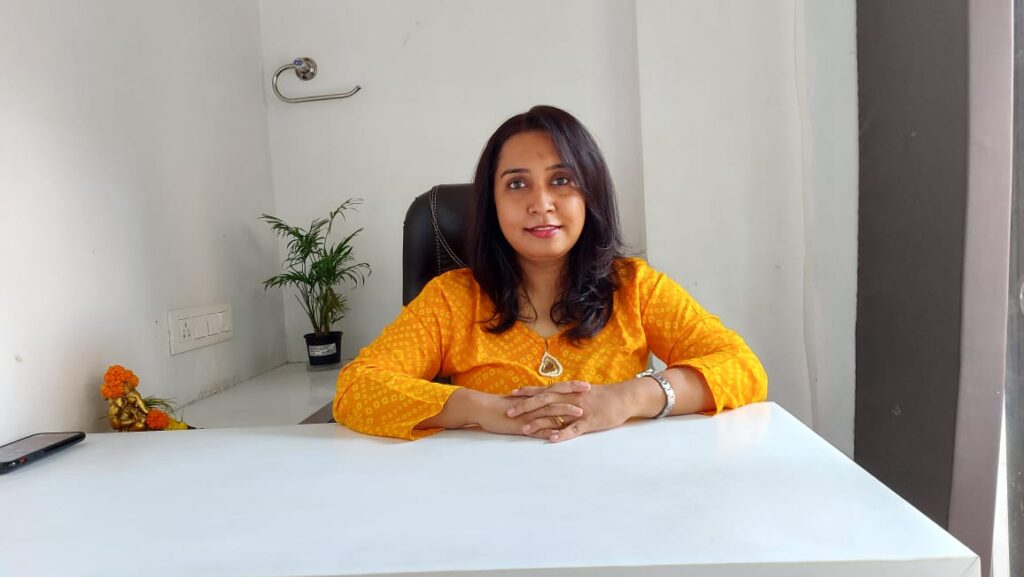- Dr Madhavi’s Healthy Smile Dental Clinic
Healthy life begins with healthy teeth
A dental clinic founded on values, driven by scientific approach & technologies with world class hygiene.
Providing quality & comprehensive dental care since 2007. We have four branches located in Bhayander, Kashimira & 2 in Mira Road (East). Our satisfied patients are from across the globe.
The clinic is led by Dr. Madhavi Jadhav along with the team of dental specialist, trained & courteous staff, skilled & qualified technicians. We are also specialised in NRI dental care.
- Affordable Package
- Best Sterilisation Process
- Experienced Doctors & Staff
- NRI Dental Care


- Meet The Doctor
Dr. Madhavi Jadhav from the “Dr Madhavi’s Healthy Smile Dental Clinic” chain of clinics has the expertise of over 19 years and is one of the finest dentists in Mumbai. She completed her bachelor’s in dental science from DY Patil University School of Dentistry in 2005.
Treat Yourself To
Comprehensive Dental Services
Why Choose Us
Our team of highly trained Dentist’s use the latest and the best Dental technologies from all across the Globe, to provide you Painless Dental treatments – quickly and easily. We thoroughly evaluate & treat all of the contributing root factors related to your Dental issue.

State of the Art Clinic
World Class Technologies to deliver the Best Results.

Excellence Guaranteed
Our passion is to deliver Great Results, not just false hopes.
We treat you with respect, listen to your concerns and take the time to treat you as an individual. We assure you complete Hygiene standards, Excellent quality treatments and a unique enriching Dental experience.

Focus on Patient Care
Patient is our utmost priority.

In-House OPG Machine
We have our own OPG Machine which is highly advanced.

Intraoral 3D Scanner
Advanced intraoral 3D scanning for accurate impressions and seamless dental care solutions.

Full Mouth X-ray
Comprehensive dental imaging with full mouth X-rays for precise diagnosis and treatment planning.
FAQ's
- Buy toothbrushes with soft bristles. Medium and firm ones can damage teeth and gums. Use soft pressure, for 2 minutes, two times a day.
Both powered and manual toothbrushes clean teeth well. Manual brushes with mixed bristle heights or angled bristles clean better than those with all flat, even bristles. Powered toothbrushes may be easier if you have trouble using your hands.
Set a reminder to replace your toothbrush every 3-4 months. Toss it sooner if the bristles look bent or splayed out. Bent bristles don’t clean as well. (They’re also a sign you may be brushing too hard.)
Most toothpastes will clear away bacteria growth and acids from food and drinks. Toothpastes with Flouride reduces onset of caries and protects teeth.
If cold or hot food or drinks make you cringe, pick a toothpaste for sensitive teeth and let your dentist know.
-Yes, daily. To start with, atleast do it once per week. It clears food and plaque from between teeth and under the gumline. If you don’t, plaque hardens into tartar, which forms wedges and widens the space between teeth and gums, causing pockets. Over time, gums pull away and teeth loosen.
Either waxed or unwaxed floss will do the job. Using floss picks or interdental brushes is another easy option.
– Mouthwashes for cavity protection, sensitivity, and fresh breath may help when you use them with regular brushing and flossing — but not instead of daily cleanings. Your dentist can recommend the best type for you.
Some people need twice-daily rinses for gum health or alcohol-free washes for dry mouth.
Kids under 6 shouldn’t use mouthwash to avoid the chance of them swallowing it.
– Visit a dentist(Dr. Madhavi’s Healthy Smile Dental Clinic)if you have any of these issues or see your child having trouble chewing or complaining of soreness:
Mouth sores
Jaw pain
Redness
Swollen face or gums
Tooth sensitivity
Broken teeth
Dry mouth
Bleeding gums
Bad breath or a bad taste in your mouth,etc
Getting checked out right away prevents more serious problems and infections.
– Regular check up help spot trouble early to prevent bigger and more costly treatments later.
A dental hygienist will start by cleaning buildup from your teeth. Then the dentist will probe spots on the surfaces and near the gumline with special tools. If it’s been a while between appointments, you may have some sore and sensitive areas.
You should get an exam every 6 months, or more often if your dentist recommends it. Find one who makes you feel at ease and lets you know what to expect. Often the dread of seeing the dentist turns to big relief when the visit is over and you have a care plan set up. Being positive as a parent can help your kids overcome any of their fears.
– Medical and dental experts study the use of X-rays and set limits for their safety. Your dentist should take as few as possible. Sometimes dentists may recommend X-rays to diagnose a special problem. Advancements in technology means today’s digital X-rays release much less radiation and are safer than in the past.
Expect to get them during a first exam after not seeing a dentist for a while. This helps check tooth and gum health. If you have gum disease, the dentist may want pictures every 6 months. For regular check-ups, it’s about every 2 years, depending on your dentist’s plan.
Kids have more X-rays done than adults because their teeth are changing and because they get cavities more easily.
– Fluoride helps make teeth strong and prevents decay. Kids should use fluoride toothpaste for brushing, taking care not to swallow it.
Adults benefit from using fluoride to protect their teeth, too.
Cavities break through the surface enamel of teeth, and they’ll probably get bigger unless you close them off with fillings.
Your dentist will numb your mouth before drilling around the cavity to prep it. A combination of strong materials or a white mix called a composite goes into the cavity soft and then hardens as it dries. You may feel pain or pressure when getting the numbing shot and during the drilling.
Once set, fillings can last a long time but need replacing if they break or wear down.
– Sealants protect against cavities that can form in the natural tiny holes and cracks on the outside of teeth. Kids from about 6 to 12 benefit from having sealants painted and hardened onto the chewing surfaces of their back teeth, or molars. Adults can get sealants as well to protect teeth that don’t have fillings.
Dentists or dental assistants put sealants on in an office visit, and it’s painless. They last around 2-4 years.
– Teeth Bleaching
Check with your dentist for advice before doing it.
Dental Office Teeth Bleaching is the best way to whiten teeth. Shining white teeth is attained with the aforesaid procedure.
– Caps and crowns cover problem teeth by surrounding them in a material that looks like a real tooth. They use the root and inside of the tooth as a base to build on, then attach with special cement.
Veneers and bonding improve your smile by sticking a layer of smoother and whiter materials like porcelain or resin to the natural tooth.
Talk with your dentist about which fix is right for you.
– Yes, sweets and foods with acid, like candy and soda, could stick to teeth and lead to cavities. Smoking and chewing tobacco can cause oral cancer and gum disease.
While teeth are strong enough to chew ice and tear open packages, this can break them and stress your jaws. Gritting or grinding down on teeth when you’re stressed may crack them.
Biting your nails is another bad habit. It pulls your jaw out of position and changes how your teeth fit together.
– Invisalign is the Pioneer company in aligners and the procedure is called as Invisalign procedure.
– Consult at Dr. Madhavi’s Healthy Smile Dental Clinic for a Digital 3D Scan and know in it detail.
– For a gist, Invisalign provides set of aligners which are digitally fabricated and customized according to patient’s mouth. They are esthetic, comfortable to wear, can remove while eating and simultaneously the crooked teeth moves in a desired manner to desired position after every set of aligner.
dental implant is one of the treatments to replace missing teeth. Their use in the treatment of complete and partial edentulism has become an integral treatment modality in dentistry. Dental implants have a number of advantages over conventional fixed partial denture.
A high success rate (above 97% for 10 years)
A decreased risk of caries and endodontic problems of adjacent teeth
Improved maintenance of bone in edentulous site
Decreased sensitivity of adjacent teeth
A dental implant is a structure made of alloplastic materials implanted into the oral tissues beneath the mucosa and/or periosteum and/or within or through the bone to provide retention and support for a fixed or removable dental prosthesis.
Its the BEST WAY to replace Missing teeth.
-Fluoride is a natural mineral that is found in many foods and in all drinking water.
Fluoride can greatly help dental health by strengthening the tooth enamel, making it more resistant to tooth decay. It also reduces the amount of acid that the bacteria on your teeth produce.
– Habit appliances are devices that are most commonly used to help youngsters stop sucking their thumbs. Habit appliances are also known as habit breaking appliances or crib appliances. Most are metal devices that are placed on the inside of the front teeth and can look like metal retainers. Some habit breaking devices can be removed, like retainers, and some are glued into place and cannot be removed. Habit breaking appliances are often held in place by the upper molars. Habit breaking appliances can both physically stop the bad habit and can serve as a reminder to not partake in the bad habit.
– A mouthguard is one of the best protection measures against oral trauma in sports. This policy statement outlines the basic principles of mouth guard design and use with a view to optimizing protection.
-Custom-made mouthguard – a tailor-made mouthguard manufactured after taking impressions or 3D scan of the user’s dentition. The dental laboratory or the specialist manufacturer creates a best-fit and comfortable mouth protector. Only available through dentists or other dental professionals working to the instruction of a dentist.
To make one for you, Visit us at Dr. Madhavi’s Healthy Smile Dental Clinic
FAQ's
Buy toothbrushes with soft bristles. Medium and firm ones can damage teeth and gums. Use soft pressure, for 2 minutes, two times a day.
Both powered and manual toothbrushes clean teeth well. Manual brushes with mixed bristle heights or angled bristles clean better than those with all flat, even bristles. Powered toothbrushes may be easier if you have trouble using your hands.
Set a reminder to replace your toothbrush every 3-4 months. Toss it sooner if the bristles look bent or splayed out. Bent bristles don’t clean as well. (They’re also a sign you may be brushing too hard.)
Most toothpastes will clear away bacteria growth and acids from food and drinks. Toothpastes with the American Dental Association (ADA) Seal of Acceptance always have fluoride, which strengthens and protects teeth. If you want a non-fluoride option, stores carry toothpastes and powders made with natural ingredients that don’t have ADA testing and approval.
If cold or hot food or drinks make you cringe, pick a toothpaste for sensitive teeth and let your dentist know.
There’s no getting around the need to get around your teeth daily with dental floss. It clears food and plaque from between teeth and under the gumline. If you don’t, plaque hardens into tartar, which forms wedges and widens the space between teeth and gums, causing pockets. Over time, gums pull away and teeth loosen.
Either waxed or unwaxed floss will do the job. Using floss picks or interdental brushes is another easy option.
Mouthwashes for cavity protection, sensitivity, and fresh breath may help when you use them with regular brushing and flossing — but not instead of daily cleanings. Your dentist can recommend the best type for you.
Some people need twice-daily rinses for gum health or alcohol-free washes for dry mouth.
Kids under 6 shouldn’t use mouthwash to avoid the chance of them swallowing it.
Visit a dentist(Dr. Madhavi’s Healthy Smile Dental Clinic)if you have any of these issues or see your child having trouble chewing or complaining of soreness:
Mouth sores
Jaw pain
Redness
Swollen face or gums
Tooth sensitivity
Broken teeth
Dry mouth
Bleeding gums
Bad breath or a bad taste in your mouth
Getting checked out right away prevents more serious problems and infections.
Regular check up help spot trouble early to prevent bigger and more costly treatments later.
A dental hygienist will start by cleaning buildup from your teeth. Then the dentist will probe spots on the surfaces and near the gumline with special tools. If it’s been a while between appointments, you may have some sore and sensitive areas.
You should get an exam every 6 months, or more often if your dentist recommends it. Find one who makes you feel at ease and lets you know what to expect. Often the dread of seeing the dentist turns to big relief when the visit is over and you have a care plan set up. Being positive as a parent can help your kids overcome any of their fears.
Medical and dental experts study the use of X-rays and set limits for their safety. Your dentist should take as few as possible. Sometimes dentists may recommend X-rays to diagnose a special problem. Advancements in technology means today’s digital X-rays release much less radiation and are safer than in the past.
Expect to get them during a first exam after not seeing a dentist for a while. This helps check tooth and gum health. If you have gum disease, the dentist may want pictures every 6 months. For regular check-ups, it’s about every 2 years, depending on your dentist’s plan.
Kids have more X-rays done than adults because their teeth are changing and because they get cavities more easily.
Fluoride helps make teeth strong and prevents decay. The American Academy of Pediatrics, the American Dental Association (ADA), and the CDC all agree that kids should use fluoride toothpaste for brushing, taking care not to swallow it.
Adults benefit from using fluoride to protect their teeth, too.
Cavities break through the surface enamel of teeth, and they’ll probably get bigger unless you close them off with fillings.
Your dentist will numb your mouth before drilling around the cavity to prep it. A combination of strong materials or a white mix called a composite goes into the cavity soft and then hardens as it dries. You may feel pain or pressure when getting the numbing shot and during the drilling.
Once set, fillings can last a long time but need replacing if they break or wear down.
Sealants protect against cavities that can form in the natural tiny holes and cracks on the outside of teeth. Kids from about 6 to 12 benefit from having sealants painted and hardened onto the chewing surfaces of their back teeth, or molars. Adults can get sealants as well to protect teeth that don’t have fillings.
Dentists or dental assistants put sealants on in an office visit, and it’s painless. They last around 2-4 years.
Stores sell many whitening products, and you can get take-home gels and trays from your dentist, but neither is as strong as procedures done in a dental office
If you want to try an over-the-counter whitener, look for one with an ADA seal. Check with your dentist for advice before you buy, especially if you have dental work or dark stains. And don’t keep using them, or you could damage your teeth.
Caps and crowns cover problem teeth by surrounding them in a material that looks like a real tooth. They use the root and inside of the tooth as a base to build on, then attach with special cement.
Veneers and bonding improve your smile by sticking a layer of smoother and whiter materials like porcelain or resin to the natural tooth.
Talk with your dentist about which fix is right for you.
Yes, sweets and foods with acid, like candy and soda, could stick to teeth and lead to cavities. Smoking and chewing tobacco can cause oral cancer and gum disease.
While teeth are strong enough to chew ice and tear open packages, this can break them and stress your jaws. Gritting or grinding down on teeth when you’re stressed may crack them.
Biting your nails is another bad habit. It pulls your jaw out of position and changes how your teeth fit together.
